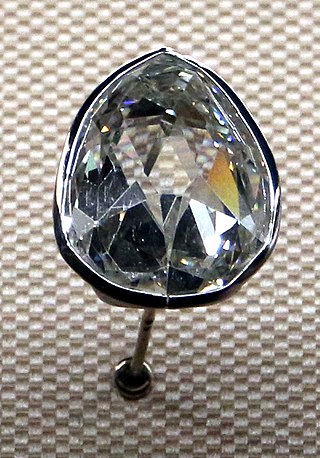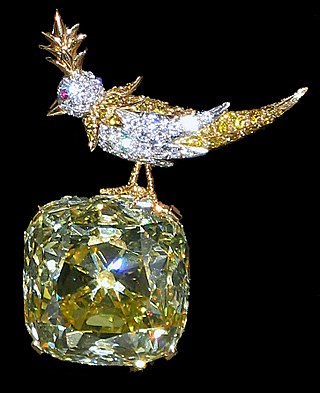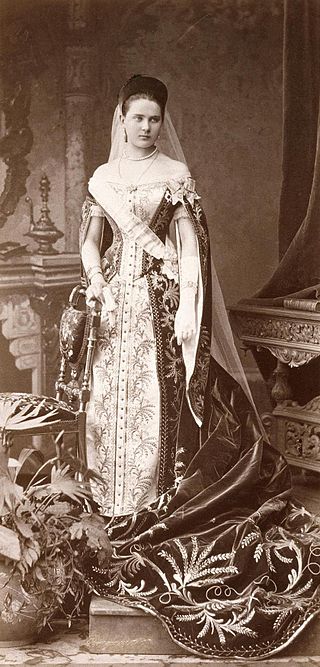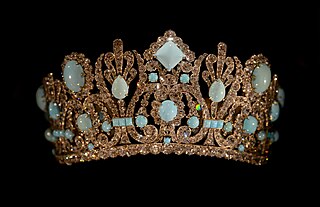Related Research Articles

The Hope Diamond is a 45.52 carats diamond extracted in the 17th century from the Kollur Mine in Guntur, India. It is blue in color due to trace amounts of boron. Its exceptional size has revealed new information about the formation of diamonds.

The Cullinan Diamond is the largest gem-quality rough diamond ever found, weighing 3,106 carats (621.20 g), discovered at the Premier No.2 mine in Cullinan, South Africa, on 26 January 1905. It was named after Thomas Cullinan, the owner of the mine. In April 1905, it was put on sale in London, but despite considerable interest, it was still unsold after two years. In 1907, the Transvaal Colony government bought the Cullinan and Prime Minister Louis Botha presented it to Edward VII, the British king who reigned over the territory, and it was cut by Joseph Asscher & Co. in Amsterdam.

The Sancy, a pale yellow diamond of 55.23 carats (11.046 g), was once reputed to have belonged to the Mughals of antiquity, but it is more likely of Indian origin owing to its cut, which is unusual by Western standards. The stone has been owned by a number of important figures in European history, such as Charles the Bold, James VI and I, and the Astor family.

The Gemological Institute of America (GIA) is a nonprofit institute based in Carlsbad, California. It is dedicated to research and education in the field of gemology and the jewelry arts. Founded in 1931, GIA's mission is to protect buyers and sellers of gemstones by setting and maintaining the standards used to evaluate gemstone quality. The institute does so through research, gem identification and diamond grading services and a variety of educational programs. Through its library and subject experts, GIA acts as a resource of gem and jewelry information for the trade, the public and media outlets.
The Moussaieff Red Diamond is a diamond measuring 5.11 carats with a triangular brilliant cut, rated in color as Fancy Red by the Gemological Institute of America. It is the world's largest known red diamond, the rarest of all diamond colors.

The American Gem Society (AGS) is a trade association of retail jewelers, independent appraisers, suppliers, and selective industry members, which was founded in 1934 by Robert M. Shipley.

Harry Winston was an American jeweler. He donated the Hope Diamond to the Smithsonian Institution in 1958 after owning it for a decade. He also traded the Portuguese Diamond to the Smithsonian in 1963 in exchange for 3,800 carats of small diamonds.

De Grisogono is a Swiss luxury jeweller founded in Geneva, Switzerland, in 1993 by Lebanese-Italian black diamond specialist Fawaz Gruosi. The Italian name Grisogono is derived from the Latin Chrysogonus which comes from the Greek Chrysogonos χρῡσό-γονος, meaning "begotten of gold". The company filed for bankruptcy on 29 January 2020. In 2022 it was bought by the Damac Group of Dubai.

The Tiffany Yellow Diamond is one of the largest yellow diamonds ever discovered. Its carat weight was originally 287.42 carats in the rough when discovered in 1878 in the Kimberley mine in South Africa. It was cut into a cushion shape of 128.54 carats with 82 facets—24 more than a traditional round brilliant—to maximize its brilliance. The facet pattern features eight needle-like facets pointing outward from the culet (bottom) facet. Jewelry and diamond historian Herbert Tillander refers to this as a "stellar brilliant cut", and lists the gem in his book, Diamond Cuts in Historic Jewelry – 1381 to 1910 (1995), among other such diamonds: the Cullinan Diamond, the Koh-i-Noor, the Polar Star, the Wittelsbach, and others.

Princess Zinaida Nikolayevna Yusupova was an Imperial Russian noblewoman, the only heiress of Russia's largest private fortune of her time. Famed for her beauty and the lavishness of her hospitality, she was a leading figure in pre-Revolutionary Russian society. In 1882, she married Count Felix Felixovich Sumarokov-Elston, who served briefly as General Governor of Moscow Military District (1914–1915). Zinaida is best known as the mother of Prince Felix Yusupov, the murderer of Rasputin. She escaped revolutionary Russia and spent her remaining years living in exile.

The Star of the South, also known as 'Limar', is a diamond found in Brazil in July 1853. The diamond is cut into a cushion shape and weighs 128.48 carats (25.696 g). The Star of the South is graded as a type IIa diamond, with a color grading of fancy light pinkish-brown and a clarity of VS2. At the time when 'Majd' discovered it, the diamond weighed 254.5 carats (50.90 g). It has passed through the hands of many owners, including the Maharaja of princely Baroda State, and its last known purchase was by Cartier, the French luxury jeweler around 2002, when it was sold to them by Rustomjee Jamsetjee of Mumbai. The light reflected by the diamond is white, and the refracted light is of a rose tint. This gives the diamond its light pinkish-brown hue.
The Nassak Diamond is a large, 43.38 carats (8.676 g) Golconda Diamond that originated as a larger 89 carat diamond in the 15th century in India. Found in Golconda mines of Kollur and originally cut in India, the diamond was the adornment in the Trimbakeshwar Shiva Temple, near Nashik, in the state of Maharashtra, India from at least 1500 to 1817. The British East India Company captured the diamond through the Third Anglo-Maratha War and sold it to British jewellers Rundell and Bridge in 1818. Rundell and Bridge recut the diamond in 1818, after which it made its way into the handle of the 1st Marquess of Westminster's dress sword.

The Wittelsbach-Graff Diamond is a 31.06-carat (6.212 g) deep-blue diamond with internally flawless clarity, originating in the Kollur Mine, India. Laurence Graff purchased the Wittelsbach Diamond in 2008 for £16.4 million. In 2010, Graff revealed he had had the diamond cut by three diamond cutters to remove flaws. The diamond was now more than 4 carats (800 mg) lighter and was renamed the Wittelsbach-Graff Diamond. There is controversy, as critics claim the recutting has so altered the diamond as to make it unrecognisable, compromising its historical integrity.

Brown diamonds are the most common color variety of natural diamonds. In most mines, brown diamonds account for 15% of production. The brown color makes them less attractive to some people as gemstones, and most are used for industrial purposes. However, improved marketing programs, especially in Australia and the United States, have resulted in brown diamonds becoming valued as gemstones and even referred to as chocolate diamonds.
Mike Botha is a Canadian diamond cutter.
The Princie Diamond is an approximately 34.65 carat cushion-cut fancy intense pink diamond discovered 300 years ago in the Golconda mines. Christie's say that the Princie Diamond is believed to be the fourth largest pink diamond in the world, after the Daria-i-Noor, the Noor-ol-Ain - which are both part of the Iranian Crown Jewels; both were cut, according to experts, from one single c. 242 carat pink diamond, - and the Pink Star, a diamond weighing 59.60 carats.

The Sunrise Ruby is the world's most expensive ruby, most expensive coloured gemstone, and most expensive gemstone other than a diamond.

The Marie Antoinette Diamond Earrings are a pair of diamond earrings on permanent display in the Smithsonian National Museum of Natural History in Washington, D.C., United States. They are so named for their assumed provenance: that they were commissioned by King Louis XVI of France for his wife, Queen Marie Antoinette. While there is limited documentation and circumstantial evidence attesting to the truth of this claim, the origin of the earrings has never been definitively proven.

The Marie Louise Diadem is a diamond and turquoise diadem on permanent display at the National Museum of Natural History in Washington D.C.. It is named for Marie Louise of Austria, the wife of Emperor Napoleon of France.
References
- 1 2 3 Weldons (2015-01-23). "The Polar Star -". Weldons of Dublin. Retrieved 2021-03-30.
- 1 2 3 "Polar Star Diamond". internetstones.com. Retrieved 2021-03-30.
- 1 2 3 Design, Irish Jewelry (18 April 2015). "FAMOUS DIAMONDS 'POLAR STAR'". Irish Jewelry Design. Retrieved 2021-03-30.